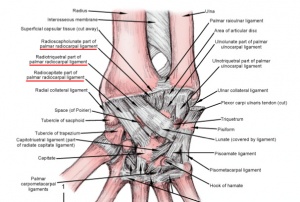Original Author – Raquel Lowe
Major Contributors – Anas Mohamed, Administration, Patti Cavaleri, Raquel Lowe, kim jackson, Richard Benes, Evan Tomás, Eva Huysmans, Naomi O'Reilly, WikiSysop, Claire Knott, Wanda van Niekerk and Amanda Ager
Content
- 1 Description
- 2 Clinically Relevant Anatomy
- 3 Epidemiology/Etiology
- 4 Differential Diagnosis
- 5 Review
- 6 Physiotherapy Management
- 6.1 Phase 1
- 6.2 Phase 2
- 6.2.1 In a next phase, the patient should perform gradual retraining exercises, including
- 6.2.2 We opt for active mobilizations over passive ones, however, passive mobilizations can be considered in specific cases to address hypomobility, incorporating traction.(4)
- 6.2.3 Following these passive mobilizations, transition to active mobilizations.(4)
- 6.2.4 You can merge mobilizations with certain stretching routines for the extensors and flexors.(4)(14)(15)
- 6.2.5 Post mobilizations, initiate exercises to enhance muscle strength.
- 7 Surgical Intervention
- 8 References
Description
A wrist twist is a ligament injury in the wrist area, involving the ligaments that link the carpal bones and those connecting the proximal row of carpal bones with the radius and ulna. An injury means the ligaments are partially or completely torn.(1)(2)
There are three degrees:(1)
1. Slight overstretching of the ligaments, without joint instability.
2. A partial ligament tear, without joint instability or with slight instability.
3. Complete ligament rupture with severe joint instability.
Clinically Relevant Anatomy
 Visual depiction of the various ligaments that are prone to twisting in the wrist joint.
Visual depiction of the various ligaments that are prone to twisting in the wrist joint.
There are two types of wrist twists, namely radial and cubital wrist twists.
- The radial wrist twist is more common and is primarily an injury to the ligaments connecting the lunate with the scaphoid, including the scapholunate ligament and the radioscapholunate ligament.(3)
- In the case of a cubital wrist twist, it could be a tear in the Triangular Fibrocartilage Complex or the Lunotriquetral complex.(4)
Epidemiology/Etiology
The most common injury mechanism is falling with the arm/hand extended, substantial impact on the thenar eminence, combined with dorsiflexion, ulnar deviation, and intercarpal supination-strain. The severity and pattern of the injury depend on the angle, power, and duration of impact during the fall.(4)(2)
The most common type of wrist twist involves a scapholunate ligament injury following hyperextension, which can lead to carpal instability.(5).
Wrist twists involving TFCC injury may result from axial loading or forearm distraction or due to repetitive movements.(5).
Differential Diagnosis
When a patient presents with functional disorders and pain post-acute wrist trauma, it is crucial to ascertain if there is a fracture. In most cases, an X-ray will be taken for diagnosis. Researchers are currently working on establishing the ‘Amsterdam Wrist Rules,’ akin to the ‘Ottawa Ankle Rules’ we are familiar with. The study’s aim is to lay down guidelines on whether a wrist X-ray should be done or not.(6)
Pain on the ulnar side in patients with wrist twists may indicate TFCC damage(5). Reproduction of pain with palpation of the ulnar fovea may suggest involvement of this region in the injury(5).
Dorsal-radial pain with an inability to bear weight with an extended wrist (like a flexion) may indicate scapholunate ligament involvement.(5). Pain on palpation over the dorsal-radial wrist. Scaphoid shift test and plain X-rays may indicate an injury in this region(5).
Review
- We will initiate the review with history-taking. During this questionnaire, we want to know more about the injury’s origin and can already inquire if there is any functional disorder (as per the patient). Let the patient describe the symptoms, the most common complaint being «pain,» let the patient define this pain. It’s also pivotal to inquire about therapy expectations. You can also gather information on prior injuries and any potential factor that may hinder the healing process. (7)(8)(9)
- Post history-taking, an inspection of the injured wrist against the other wrist should be conducted. A twisted wrist may be swollen, red, tender, and warm to touch.(1)(7)(8)(9)
- Following the inspection, palpation of the wrist and its structures should be performed. Most wrist structures are palpable, but swelling may hinder palpation and cause pain to the patient.(4)(10)
- Subsequently, each joint should be tested for pain, abnormal movement, or crepitus. Wrist’s physiological movement can be assessed through simple tests of palmar flexion, dorsiflexion, radial deviation, and ulnar deviation.(9)
- Functional movement should also be tested letting the patient perform activities like grasping, pinching, holding, and handling simple objects.(9)
- You can conduct a strength assessment to verify if muscle strength remains normal. You should test this for flexion (Fig.5), extension, and radial and ulnar deviation.(9)
Note that this can be very painful or even impossible for patients with a severe wrist twist when passive movements are already painful and not entirely feasible. - The results of your tests and thus the functional disorders will hinge on the severity of the injury.(4)(7)(9)
You can also conduct more specific provocative wrist tests.(4)(7)(10)
- Scaphoid Watson’s shift test
- Lunotriquetral vote test
- Finger extensions against resistance.
- Midcarpal test
- Distal radioulnar joint test
- Triangular fibrocartilage complex stress test
- Triangular fibrocartilage complex stress test with compression
- Rotational impaction stress test
These tests will provide more insights into which ligaments are (partially) torn and the wrist’s instability.(4)
Prosser et al(10) compared wrist provocative tests and MRI diagnosis with arthroscopic findings to assess their diagnostic value in 105 patients. The scaphoid shift test, midcarpal test, and DRUJ test had moderate diagnostic utility. MRI was considered moderately useful for diagnosing TFCC injuries and slightly useful for diagnosing scapholunate ligament injuries.(10).
Physiotherapy Management
Mild wrist twists should follow the RICE method (as discussed below) and may improve within 24 to 48 hours.(5).
Moderate to severe wrist twists may necessitate orthotic devices to promote area protection and


